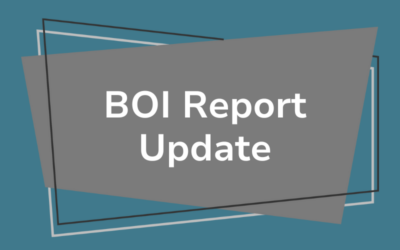Despite your best efforts to choose the perfect name for your company, there may come a time when that name no longer is the best fit. Perhaps the business name no longer accurately reflects your brand or there are legal considerations at play. Regardless of the reasons to make a business name change, it’s a process that many entrepreneurs find confusing. The steps involved can vary depending on the business entity type and state of registration.
You may not expect ever to have to change your company name but knowing what to expect will help alleviate some of the stress if ever you do face the task. So, together, let’s break down what sole proprietorships, partnerships, LLCs, and corporations typically need to do to change their company name.
What I’ll share here will give you a basic understanding of what’s involved to modify a business name; it is not a replacement for professional advice from an attorney. Because changing your business name may have legal implications, I suggest discussing your options with a licensed business lawyer before moving forward.
Sole Proprietorships and General Partnerships
Sole Proprietorships and General Partnerships are not formally registered business structures with the state, and the IRS considers these forms of business the same tax-paying entity as their owners. The name of a Sole Proprietorship or Partnership contains the owners’ first and last names, but owners can choose to market their business under a fictitious name—also called a trade name or DBA (Doing Business As)—that’s more creative and interesting.
Getting a DBA requires filing paperwork with the state. Some states also require that the business owner place a notice in one or more local publications to make the public aware of the DBA and who owns the business using it. If a business owner files a DBA and then later decides to change the name, they may do so if they follow the proper process.
The basic steps for sole proprietorships and partnerships to change their DBA include:
- Cancel the existing DBA and file for a new one with the state. This involves contacting the government authority responsible for approving and registering fictitious names.
- Contact the bank to find out if the existing business bank account’s name can be changed. Some banks will change the name on the account to a new DBA, while others require closing the account in the old name and opening a bank account for the new DBA.
- Check with the city, county, and municipal government authorities about how business licenses and permits should be handled. Ask if the business’s existing business licenses and permits can be updated to reflect the new DBA or if the new DBA needs to obtain new licenses and permits.
- Ask the IRS if a business name change will affect the business’s Employer Identification Number. Find out if getting a new DBA will require applying for a new Employer Identification Number. Typically, a new EIN isn’t necessary when changing a business name. However, if the business is changing its entity type in addition to its name, then a new EIN is required.
- Notify the IRS of the new DBA.
- Update any customer service documents and sales and marketing assets to reflect the new DBA. Things like customer contracts, sales estimates, company website, and letterhead are among the materials that may need revamping.
Limited Liability Companies
A Limited Liability Company (LLC) has two options for changing its business name. The first is to extinguish the original business name and register a new one. The second is to maintain the original name as the entity’s legal name and create a DBA for marketing and branding purposes.
Option 1: File LLC Articles of Amendment with the state to change the business name
By filing a document called Articles of Amendment, an LLC can request to change its business name. After the state approves the Articles of Amendment, the LLC will operate under its new name and the old name will be no longer active. If an LLC has foreign qualified (is registered) in other states, the company must file Articles of Amendment in all of those states.
In addition to taking care of the name change at the state level, LLC owners may also need to do some of the following steps depending on their situation:
- Contact their bank to find out if they can change the name on their existing business bank account or if must they open a new business bank account for the new name.
- Check with the city, county, and municipal government offices to find out if they must update existing business licenses and permits with the new business name or cancel the existing licenses and get new ones under the new business name.
- Find out if the business must apply for a new EIN under the new business name. Although a name change in itself generally does not require getting a new EIN, it’s best to verify with the IRS.
- Notify the IRS of the LLC’s new business name. A single-member LLC would handle this the same as a sole proprietorship would; a multi-member LLC would follow the same procedure as a general partnership.
- Update the company’s customer service documents and sales and marketing assets. A new name means all of the contracts and communications the LLC uses should reflect that new name. Among the things that may need to be updated are company logo, service contracts, sales presentations and proposals, website, brochures, and company letterhead.
Option 2: Keep the original name as the LLC’s registered business name and file a DBA for the new name
Wiping the slate clean and doing a complete business name change may work well for LLCs without a lot of brand awareness and reputation tied to their name. For some companies, though, it may make more sense to keep the existing name intact. That might be the case if the LLC has trademarked the name or has products and services strongly associated with the name.
To accomplish this, a business may file a DBA (i.e., fictitious or trade name) for the desired business name with the state or county office that has authority over DBAs. After filing the DBA, the business owners should contact the bank to discuss if the DBA can be added to the LLC’s existing bank account or if it will need a separate account set up in its name. After the DBA is set up, the next steps include creating internal and external administrative and marketing materials (such as logo, letterhead, website content, etc.) that reflect the name and establish a foundation for promoting the brand.
C Corporations
A company registered as a C Corporation has methods similar to those that an LLC has for changing its business name.
Option 1: File Articles of Amendment with the state to change the corporation’s business name
C Corporations can request the make a business name change by filing Articles of Amendment with the state. Upon approval, the corporation will operate under its new name. As is the case with a foreign qualified LLC, a corporation that is registered in multiple states must file Articles of Amendment in each state where it has a foreign qualification.
Beyond taking care of the state business registration aspect of a name change, entrepreneurs may also need to tackle other steps:
- Contact the bank to find out if they can change the business name on the existing bank account or if they must open a new business bank account under the new business name.
- Check with the city, county, and local government offices to see what needs to be done to existing business licenses and permits. Can they be updated with the new name or must those licenses and permits be canceled and new ones obtained under the new name?
- Ask the IRS if the corporation must apply for a new EIN under its new name. Usually, a new EIN will not be necessary if a business changes its name, but it’s best to confirm.
- Notify the IRS of the corporation’s new name.
- Update the corporation’s customer service documents and sales and marketing materials with the new name. Assets to consider include company logo, letterhead, service contracts, vendor contracts, sales proposals, website content, brochures, and catalogs, etc.
Option 2: Keep the corporation’s original name as the registered business name and file a DBA for the new name
As I mentioned in the section about LLCs, in some situations, it might be more favorable for a corporation to maintain its registered name as its legal entity name and file a DBA with the appropriate government agency for the new name it wants to use. After filing the DBA, the corporation should contact the bank to find out if it can add the DBA to the company’s existing bank account or if it will need to establish a separate business bank account for the DBA. After the DBA is approved, the business should consider creating customer documents, corporate communications, and marketing materials (such as service contracts, proposals, company logo, letterhead, website content, etc.) that reflect the name and can be used to promote the brand.
Final Tips for Business Name Changes
Before you decide (after consulting your attorney) which method of changing your business name is most favorable, you want to verify that the name you want to use is available. CorpNet offers a free business name search tool to help you determine if a name isn’t already claimed legally by another business. I also recommend using the United States Patent and Trademark Office’s online database to help detect any potential conflicts. An attorney that specializes in trademarks can also assist in confirming a name’s availability.
After you know what name you will use and how you’ll proceed with your business name change, my team of filing experts at CorpNet can handle the name change paperwork for you. Whether it’s filing a DBA or Articles of Amendment, we can get the job done quickly and usually much more affordable than paying an attorney’s fees to process the documents. Contact us today to get started!
Need Changes Made to Your Business?
By having CorpNet process and file your Articles of Amendment you’ll save both time and money with services that are fast, reliable, and affordable. And our services are backed by a 100% satisfaction guarantee, so you know you’re in good hands.





